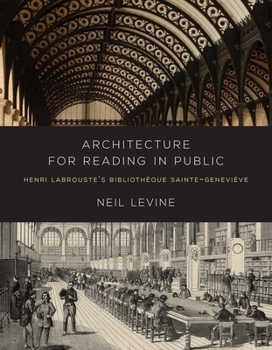Architecture for Reading in Public: Henri Labrouste's Bibliotheque Sainte-Genevieve
An in-depth look at the iconic mid-nineteenth-century building and its construction during a period of revolution and its transformative impact on the history of architecture Since its completion in 1850, the Biblioth que Sainte-Genevi ve has been heralded as a major forerunner of modern architecture. The architect Henri Labrouste, a product of the cole des Beaux-Arts, broke with the reigning neoclassical tradition by expressing on the exterior the building's internal functions and exposing on the interior the unprecedented iron construction of its reading room. Underlying these radical departures from tradition was a new democratic form of spatial organization appropriate to the new reading public. Acclaimed architectural historian Neil Levine presents both a building history--discussing the significance of the program, site, prehistory, and building process--and a window into a period of momentous historical change by contextualizing Labrouste's work within the revolutionary times of the latter part of the July Monarchy and Second Republic in France. He examines how the building communicates a public purpose through its anticlassical, nonhierarchic, egalitarian form and reveals how the Biblioth que Sainte-Genevi ve is the product of a poetic architectural intelligence mixed with radical, democratic ideals.
Format:Hardcover
Language:English
ISBN:0300275331
ISBN13:9780300275339
Release Date:July 2025
Publisher:Yale University Press
Length:296 Pages
Related Subjects
ArchitectureCustomer Reviews
0 rating





